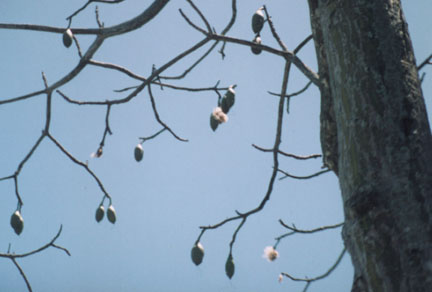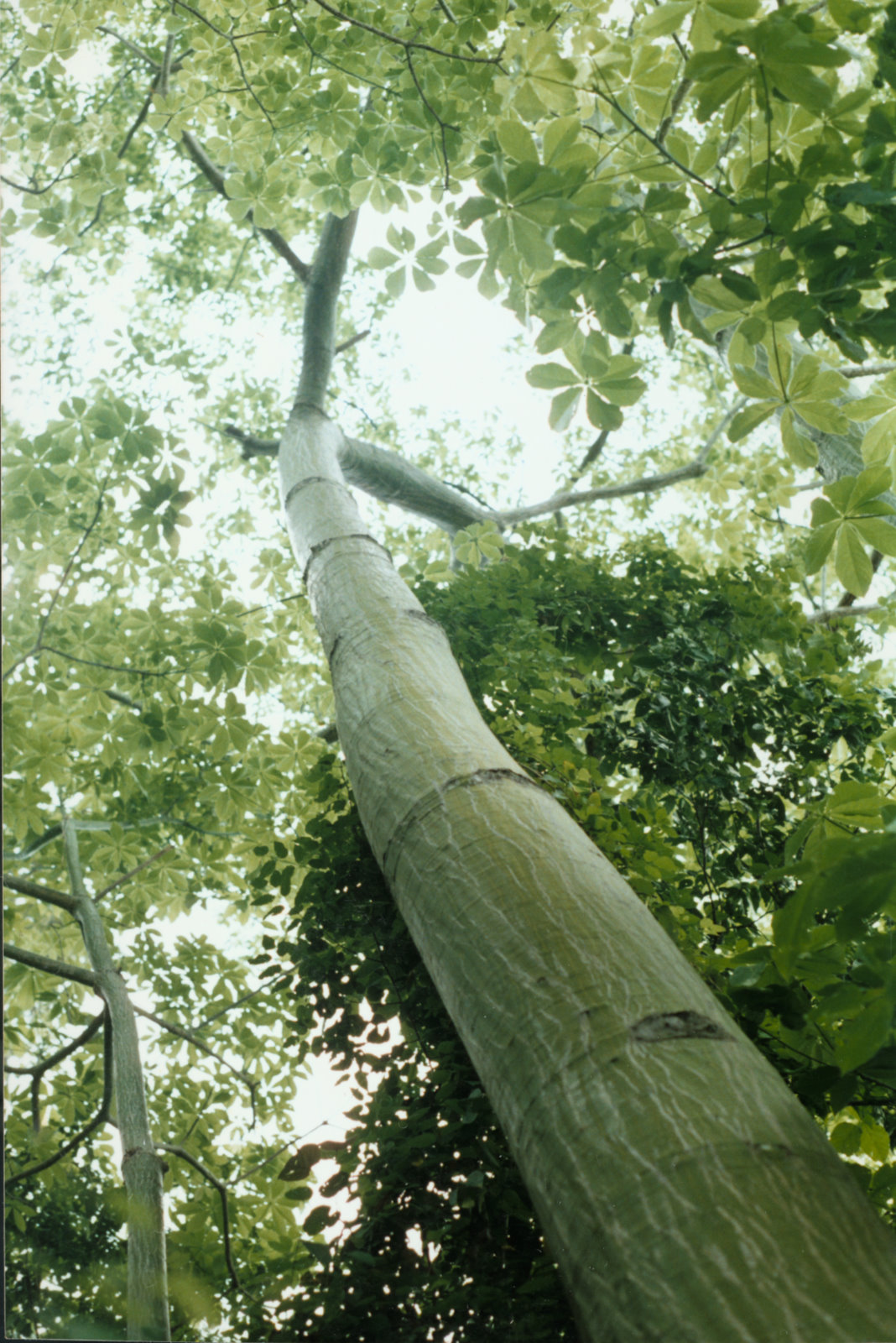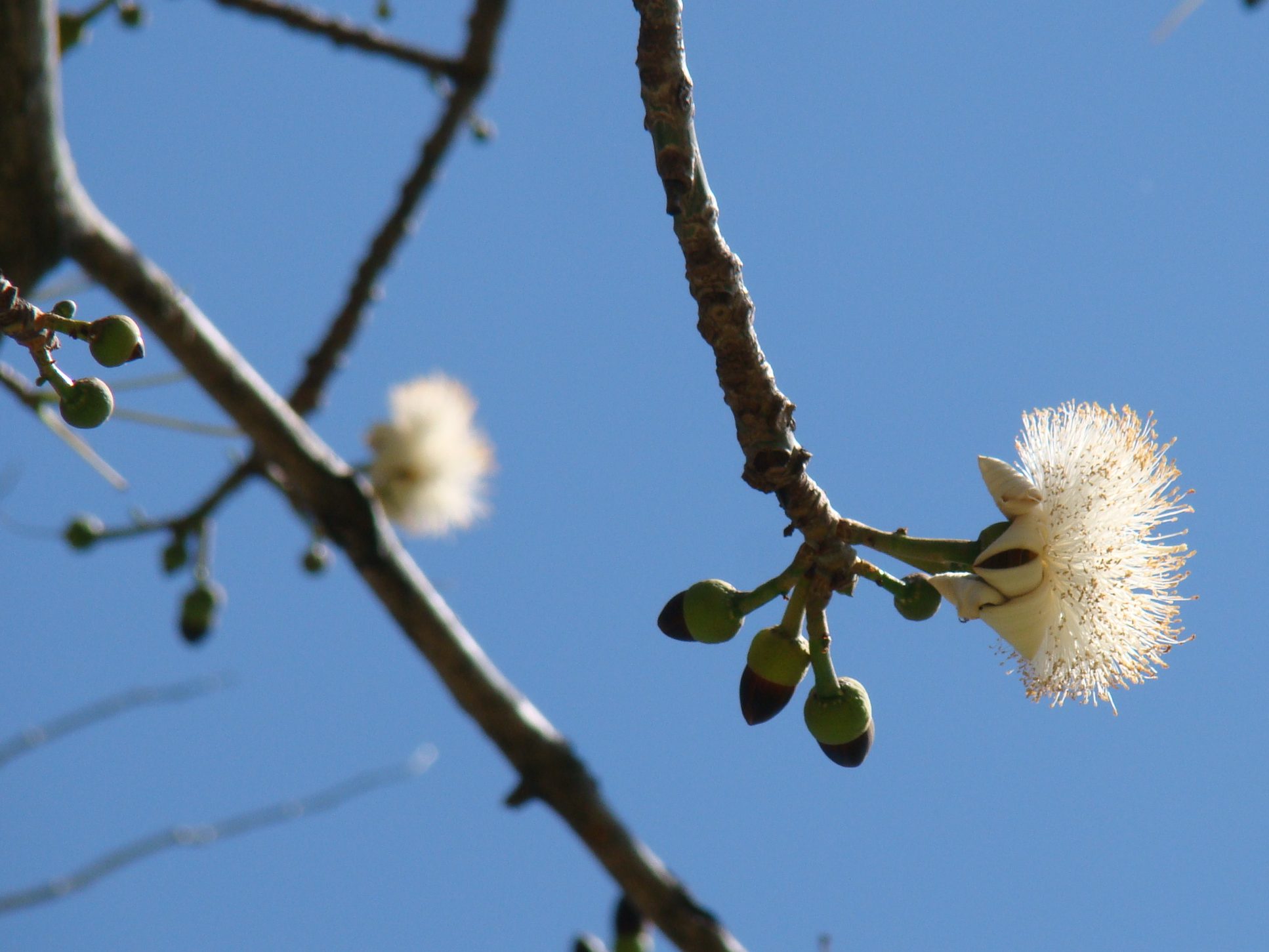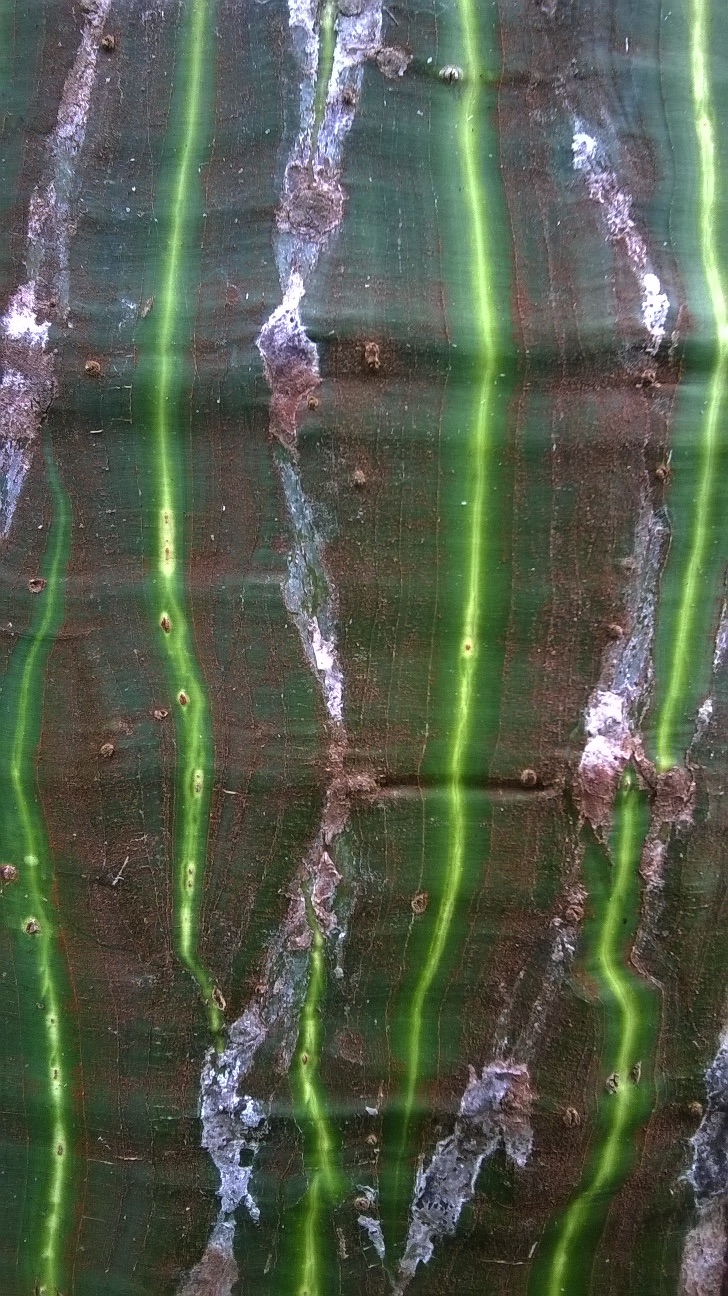Pseudobombax septenatum (Jacq.) Dugand
Bombacaceae CEIBO BARRIGÓN
Occasional deciduous canopy tree (20-30 m) growing in great abundance along Costa Rica’s Pacific coastline – particularly in sites prone to excessive dryness due to shallow or sandy soils, southern exposures, extended dry seasons or a combination of these factors. Barrigón is an especially memorable tree species thanks to a number of unusual and intriguing characteristics such as its barrel-shaped, green-striped bole; its huge, thousand-stamen flowers; and its few, highly-angled, stout limbs. This species is a close relative of the pantropically distributed Ceiba or Kapok tree (Ceiba pentandra), with which it shares many attributes.
Description: Barrigón’s trunk (1 m), though circular in cross-section and mostly straight, often shows some angular bending as it rises up to the forest canopy. The bole is periodically noded with prominent scars that mark where old limbs were once attached. About a meter above the ground, most Barrigón trunks sport a noticeable swelling – they have greater diameters at this height than either above or below it. The pot-bellied appearance this creates has been immortalized in the Spanish common name for this species: “Ceibo Barrigón” – or “big-bellied Ceiba”. From a distance, the smooth, glossy bark appears light gray but closer inspection resolves it into a complex and striking pattern of wide, parallel, and somewhat wavy, green and gray stripes. Branches are few in number and they are usually restricted to the upper portion of the bole. There, the thick (though short) limbs emerge nearly horizontally and extend outward, while subdividing minimally into relatively few, fat and stubby twigs. Barrigón’s irregularly shaped crown is therefore very thin and open. Leaves are large (30 cm by 20 cm), palmately compound, and alternate. Composed of seven elliptical to oblanceolate leaflets (14 cm by 7 cm) with short drip tips, they are supported by a long petiole (20 cm). Foliage begins senescing late in the year and it is slowly and completely shed during December – the beginning of the dry season. New leaves do not appear until May, when the rains have resumed.
Coinciding with leaf loss is the appearance of flower buds high in the crown. Each of these structures possesses a cup-shaped green calyx and five dark brown, interwoven petals that form a dome-like cover over the flower interior. When open, the large and unusual Barrigón blossom is dominated by a staminal ring composed of over a thousand, long (6 cm) white stamens and formed into a stringy globe. The fleshy petals, curled back over the calyx, are also white, as is the thick, central pistil. Opening in the early evening, blossoms are spent by the following morning when the petals and stamen clusters are shed (and can be found on the ground). Flowering occurs from January through April but with most intensity during February. Fruits develop rapidly into large (10-15 cm), ellipsiod, dehiscent, woody capsules. Their smooth, glossy exteriors are green, though mottled with brownish striping. Vertically oriented, the large pendulous pods slowly accumulate among the bare branches of the dry season Barrigón crown. Inside them, many brown, thin-coated, spherical seeds (0.5 cm) are wrapped in buff-colored, cottony fibers. After drying in the summer sun, the pod splits into five, wedge-shaped sections that are then shed – leaving the cottony fiber mass clinging to the old pedestal high in the tree. Slowly, breezes tug at the seeds and dislodge them – each with its own cottony parachute – and they drift slowly to the ground while being nudged laterally by the wind. Harvests last from March through May. Seeds germinate with the first consistent and drenching rains of May and June. Sometimes seen dotting the ground near the parent tree, the young seedlings are easily recognized by their spade-shaped (still simple) leaves.
Similar Species: Palo Verde (Bombacopsis sessilis), Indio Desnudo (Bursera simaruba) and young Ceiba (Ceiba pentandra) trees all have green, photosynthetic trunks. However, only Barrigón boles display green and gray striping – a hallmark of the species.
Natural History: Barrigón’s large, fragrant flowers – open only at night – are pollinated by bats and large moths. Its seeds are dispersed, very effectively, by wind – the long cottony fibers serving to balloon them though the air and later roll them over the ground.

As with many other reproductive strategies, the timing of the various stages of fertility is critical. Flowers appear during the dry season, when there is no obscuring foliage present in the crowns to hide them. Fruits that need to desiccate in order to open, mature during the summer months when sunlight is plentiful and the air is driest. Seeds are released just weeks before the start of the life-giving rainy season – giving the rapidly-germinating seedlings the maximum amount of time possible to establish adequate root systems before the onset of the next, potentially lethal, dry season.
Most of the other adaptations possessed by this tree species enable it to survive in periodically dry habitats. Since trees lose much of their moisture though the leaves, being deciduous at a time when water is not available (being either frozen, as in north-temperate winters; or scarce, as in tropical dry seasons) helps them avoid desiccation. Leafless, Barrigón has a further advantage over most deciduous species for the chlorophyll in its green bark stripes allows it to continue the sugar-producing process of photosynthesis. Finally, the fatness of Barrigón’s bole hints at its water-storing capabilities. Many members of the Bombacaceae family – even those without swollen boles – have developed the ability to harbor water in this way.
The paucity of branches and small twigs in the Barrigón crown and the consequent high levels of insolation it experiences during the dry season make this tree an excellent host to many species of epiphytes. Individuals often have limbs that are covered with these commensalistic plants, bromeliads and orchids being among the most common.
Finally, Barrigón is an extremely salt-resistant tree, and it is able to grow closer to the open ocean than almost all other tropical species. Walking the beaches of the Osa or Nicoya peninsulas, large, conspicuous trees periodically dot the immediate coastline, thriving in the harsh habitat that lies just above the high water line.
Uses: Barrigón seeds are edible and can be toasted, giving them a nutty flavor. The cotton of the fruit pods is soft and similar to that found in the Kapok tree, and could potentially be used as stuffing for furniture and pillows. Finally, the wood is light, soft, and not valued as lumber – though it has been employed in molds for cement.
Distribution: In Manuel Antonio National\ Park, Ceibo Barrigón is a sporadic resident of the interior forest but it is found most commonly along the sandy coast and lining the steep slopes of south-facing hillsides – like those behind Puerto Escondido – where water is scarce. This species is also known from Costa Rica’s Corcovado, Palo Verde, Santa Rosa, Curu, and Cabo Blanco national parks and biological reserves. It ranges from Nicaragua to Brazil and Peru.
Photos: Tree Tree2 Trunk Bark Leaf Flower Bud Flower Flower2 Flower3 Flower4 Fruit Fruit2




